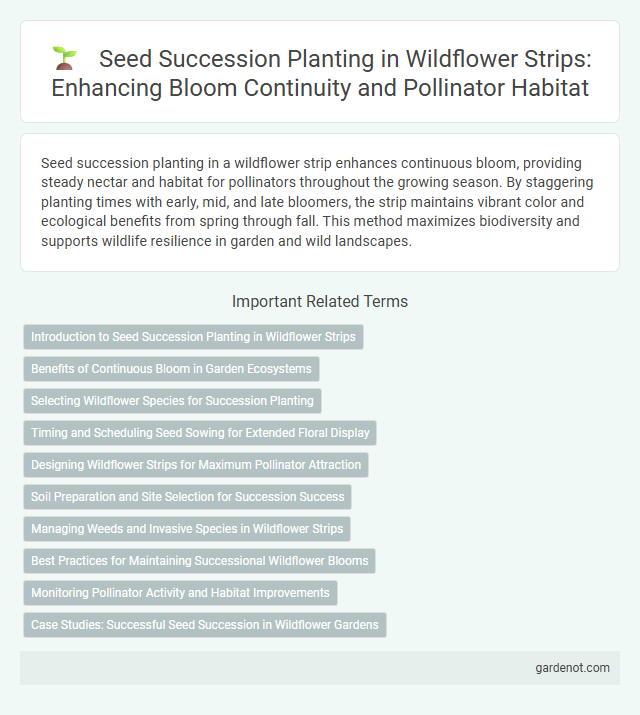Seed succession planting in a wildflower strip enhances continuous bloom, providing steady nectar and habitat for pollinators throughout the growing season. By staggering planting times with early, mid, and late bloomers, the strip maintains vibrant color and ecological benefits from spring through fall. This method maximizes biodiversity and supports wildlife resilience in garden and wild landscapes.
Introduction to Seed Succession Planting in Wildflower Strips
Seed succession planting in wildflower strips ensures continuous bloom by staggering seed sowing times for various species. This technique promotes biodiversity, supports pollinators throughout the growing season, and enhances habitat resilience. Proper understanding of species-specific germination periods and growth cycles maximizes floral display and ecological benefits.
Benefits of Continuous Bloom in Garden Ecosystems
Seed succession planting in wildflower strips ensures a continuous bloom, supporting pollinators like bees and butterflies throughout the growing season. This method enhances biodiversity by providing a sustained food source and habitat, which improves ecosystem resilience. Continuous blooming also aids in soil health by promoting diverse root systems and reducing erosion.
Selecting Wildflower Species for Succession Planting
Choosing wildflower species for seed succession planting involves selecting a diverse mix of early, mid, and late bloomers to ensure continuous flowering throughout the growing season. Native wildflowers such as Black-eyed Susan (Rudbeckia hirta), Purple Coneflower (Echinacea purpurea), and Butterfly Weed (Asclepias tuberosa) are ideal for regional adaptability and attracting pollinators. Proper species selection supports ecosystem health, enhances habitat connectivity, and maintains aesthetic appeal in wildflower strips.
Timing and Scheduling Seed Sowing for Extended Floral Display
Timing seed sowing in wildflower strips involves staggering planting dates from early spring to late summer to ensure continuous blooming and extended floral display throughout the growing season. Selecting species with varying germination periods and growth rates enhances succession planting, allowing different flowers to peak at different times. Proper scheduling considers local climate and soil conditions, optimizing seedling establishment and maximizing pollinator attraction.
Designing Wildflower Strips for Maximum Pollinator Attraction
Designing wildflower strips for maximum pollinator attraction involves selecting a diverse mix of native wildflower species with staggered bloom times to ensure continuous nectar and pollen supply throughout the growing season. Implementing seed succession planting techniques enhances floral availability, supporting a broad range of pollinators such as bees, butterflies, and hoverflies. Strategic arrangement and rotational sowing promote ecological resilience, increase habitat complexity, and optimize pollination services in agricultural and natural landscapes.
Soil Preparation and Site Selection for Succession Success
Choose a well-drained site receiving at least six hours of sunlight daily to promote healthy wildflower growth during seed succession planting. Prepare the soil by removing existing vegetation, loosening the top 6-8 inches, and incorporating organic matter to improve soil structure and nutrient availability. Selecting a location with varied microenvironments and ensuring proper soil pH between 6.0 and 7.0 optimizes seed germination and supports successive blooming cycles.
Managing Weeds and Invasive Species in Wildflower Strips
Seed succession planting in wildflower strips promotes continuous bloom and strengthens plant diversity, which outcompetes weeds and invasive species naturally. Regularly monitoring and selectively removing invasive plants prevents them from establishing dominance, preserving native flora integrity. Implementing a planned sequence of native seed varieties improves soil health and resilience, further suppressing weed proliferation effectively.
Best Practices for Maintaining Successional Wildflower Blooms
Successional wildflower planting ensures continuous blooms by staggering seed sowing in phases from early spring through late summer. Selecting native species with varied bloom times and focusing on site-specific soil and sunlight conditions enhance flower diversity and longevity. Proper site preparation, regular monitoring, and timely thinning prevent overcrowding and promote healthy plant growth throughout the season.
Monitoring Pollinator Activity and Habitat Improvements
Seed succession planting in wildflower strips promotes continuous bloom, enhancing habitat quality for pollinators by providing nectar and pollen resources throughout the growing season. Monitoring pollinator activity through systematic surveys and observational studies helps assess the effectiveness of habitat improvements and guides adaptive management strategies. Implementing diverse native seed mixes tailored to local ecosystems supports a resilient pollinator community and boosts biodiversity within agricultural landscapes.
Case Studies: Successful Seed Succession in Wildflower Gardens
Case studies demonstrate that seed succession planting in wildflower gardens extends blooming periods by strategically sowing species with staggered germination times. Research from the University of California reveals that sequential sowing of native wildflowers increases floral diversity and supports pollinator populations throughout the growing season. Projects in the Midwest show up to 45% more continuous bloom and enhanced habitat for bees and butterflies using tailored seed succession schedules.
Seed succession planting Infographic

 gardenot.com
gardenot.com